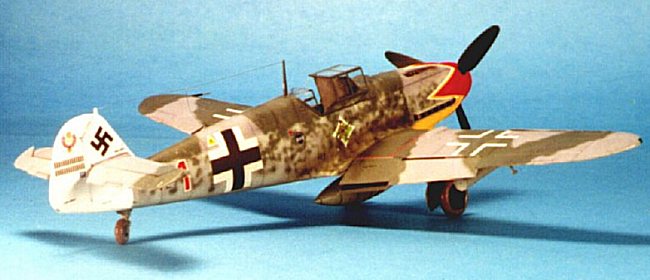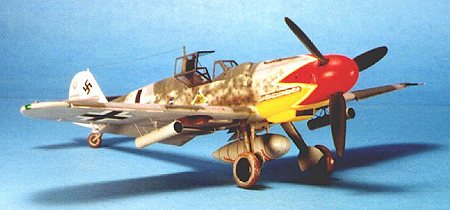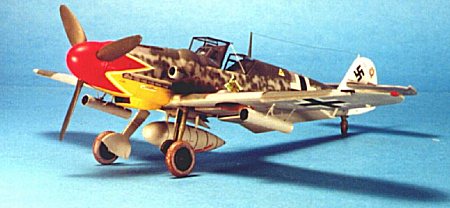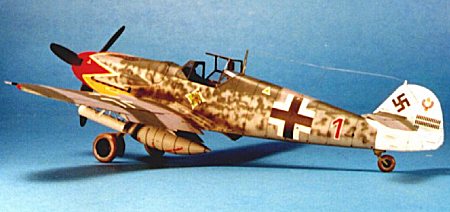
|
KIT: |
Hasegawa 1/48 Bf-109G |
|
KIT # |
09314 |
|
PRICE: |
$24.98 |
|
DECALS: |
One set of markings for Bf-109G-6, JGr50, 1943 |
|
REVIEW & |
|
|
NOTES: |
|

|
HISTORY |
By the summer of 1943, the Germans faced two separate - but not unassociated - problems: the ever-expanding American daylight bombing offensive, and the ubiquitous presence of the Mosquito over Germany and the rest of occupied Europe. When the Mossies of 105 and 139 Squadrons disrupted a morning speech in Berlin by Dr. Josef Goebbels in February 1943, that was bad enough; when they returned that afternoon and send Reischmarshall Hermann Goering to bomb shelter mid-speech, that was adding insult to injury. Goering decided to fight fire with fire.
Major Hermann Graf, the first Luftwaffe experte to reach the double century mark, was at the time on rest leave in France, officially in charge of advanced fighter pilot training. He was brought to Berlin and placed in charge of a special unit, JG50, whose assignment it was to stop the Mosquito. The Jagdgeschwader was never of more than Gruppe strength, and was often referred to as Jagdgruppe 50 (JGr50). While Graf was able to get experienced pilots assigned to the unit, it was by no means a "Gruppe of experten" like JV44 would be two years later. The unit was equipped both with specially supercharged Fw-190A-5s, and the new Bf-109G-6, with its increased engine power and heavier armament.
 During the course of time
that JGr50 was getting organized, the USAAF's Eighth Air Force had expanded to
the point they could launch over 200 B-17s and B-24s on a maximum-strength
mission over Germany, and were venturing farther and farther beyond the range of
their fighter escorts as they put into practice the theory of the
"self-defending bomber formation." It was during this period that the
"company front" or - as known to the Americans - the "twelve
o'clock high" head-on diving attack into the bomber formations was
developed by Egon Mayer of JG2.
During the course of time
that JGr50 was getting organized, the USAAF's Eighth Air Force had expanded to
the point they could launch over 200 B-17s and B-24s on a maximum-strength
mission over Germany, and were venturing farther and farther beyond the range of
their fighter escorts as they put into practice the theory of the
"self-defending bomber formation." It was during this period that the
"company front" or - as known to the Americans - the "twelve
o'clock high" head-on diving attack into the bomber formations was
developed by Egon Mayer of JG2.
Even with the higher-powered aircraft, Graf was not achieving success against the Mosquito raiders; this was because their leader, Wing Commander Hughie Edwards, had adopted the tactic of low-level attacks. At altitude, with proper radar guidance and enough warning, the aircraft of JGr50 were fast enough to catch a Mosquito. However, at low level the Mossies were operating below radar cover, so that the timely warning was not possible, in addition to the fact that the Mosquito at low level was approximately 8mph faster than an Fw-190 at full throttle; a narrow margin, but there is the old saying "an inch is as good as a mile."
Graf was given the assignment of assessing new methods of attacking the American bomber formations. He was to work out the operational policy for the "company front" attack, and other attack possibilities, and assess other weapons the fighters could use against the bombers. These new weapons slowed both the Fw-190 and the Bf-109 and degraded their performance as regards fighter-versus-fighter combat. However, the idea now was to wait to make the main attack on the bombers until their escorts had turned back due to their short range. Once the P-47s were gone, Fw-190s and Bf-109s with additional cannons, rockets and even bombs could have their way with the bombers.
JG50 was the first formation to use the WfGr.21 rocket mortar, with one under each wing of their aircraft. These rockets could bring down a bomber with one hit, though they were little more accurate than the mortars they were adapted from.
Graf gained two victories over B-17s using these rockets on September 6, 1943.
With the tactics and weapons now proven in such battles as Black Thursday, the second USAAF mission to Schweinfurt which saw 60 of 290 attacking bombers shot down and the Eighth Air Force left with less than 100 bombers capable of flying another mission the next day after their return to England, JGr50 was disbanded in November 1943. Graf was then appointed Kommodore of JG11, the Jagdgeschwader raised out of JG1 and based in northwest Germany directly on the Eighth's path into Germany. Over the next four months he was credited with six more American aircraft, including three of the new P-51B Mustangs. The last two of these three were claimed north of Hannover on March 29, 1944, when he shot one down and rammed the second - whether this was an accident or intentional has never been made clear.
 Graf was badly injured
in the fight and had to parachute to safety. His wounds put him into the
hospital for several months, and upon his recovery he returned to the Eastern
Front and command of JG52. Captured by the Russians and sent to the Siberian
gulags with other German POWs, he was later accused by Hans "Assi"
Hahn and others of having collaborated with his captors - as a German hero from
a working class background, he had been seen by the Communists as a major prize
if they could bring him to their side. Graf was one of the few German POWs to
choose repatriation to the German Democratic Republic - the Communist-run East
Germany - when released in 1955. He died there in the 1980s.
Graf was badly injured
in the fight and had to parachute to safety. His wounds put him into the
hospital for several months, and upon his recovery he returned to the Eastern
Front and command of JG52. Captured by the Russians and sent to the Siberian
gulags with other German POWs, he was later accused by Hans "Assi"
Hahn and others of having collaborated with his captors - as a German hero from
a working class background, he had been seen by the Communists as a major prize
if they could bring him to their side. Graf was one of the few German POWs to
choose repatriation to the German Democratic Republic - the Communist-run East
Germany - when released in 1955. He died there in the 1980s.
|
THE KIT |
This is another of Hasegawa's limited-run editions of their Bf-109G-6 kit. Here, they provide the WfGr.21 tubes, in white metal and photo-etch. Other kits of the '109 have provided these as a standard fit before, but this is the first one to have tubes that look as delicate as they should, as a result of the photo-etch bracing.
|
CONSTRUCTION |
I built the kit out of the box with the exception of using the new Eduard German seatbelt set; this is very handy to get hold of: there are eight sets of seatbelts only on the fret, and the price is cheap. This is as close to a replacement of the True Details seatbelts as we are likely to see, and they are of higher quality and accuracy than their predecessors. Eduard also makes Japanese and US WW2 seatbelts in this series.
|
PAINT & DECALS |
 Outside of the white
"formation leader's" vertical fin and rudder, the model was painted in
the classic mid-war scheme of RLM76 Light Blue undersides, with RLM74 and 75
upper colors, and a fuselage dapple of RLM02, 70, and 74. I used Gunze-Sanyo
H-441 RLM76, with my upper colors of Gunze US Neutral Grey for RLM75, and a
mixture of Gunze IJN Green and Neutral Grey to create RLM74.
Outside of the white
"formation leader's" vertical fin and rudder, the model was painted in
the classic mid-war scheme of RLM76 Light Blue undersides, with RLM74 and 75
upper colors, and a fuselage dapple of RLM02, 70, and 74. I used Gunze-Sanyo
H-441 RLM76, with my upper colors of Gunze US Neutral Grey for RLM75, and a
mixture of Gunze IJN Green and Neutral Grey to create RLM74.
I used the kit decals, which provide all the markings for "Rot Ein," the Bf-109G-6 Graf flew with JGr50 in the summer of 1943. This gives a very nice five-pointed red "tulip petal" personal marking, which went on with no difficulty using some Micro-Sol to melt it over the various nose bumps.
Rocket Tubes:
After the model had been decaled and given its final finish, I assembled the rocket tubes and installed them under the wings. These are white metal, and must be glued with Cyanoacrylate glue, which is iffy at best. The photoetch braces are nice and thin, and overall the rockets have a petite appearance that looks very realistic compared to photographs, and miles better than anything produced in other kits beforehand. Being delicate, they require a light touch; once installed they will require special attention to keep from being knocked off as the model is moved around.
|
CONCLUSIONS |
As you can see from the photos, the model looks good. I found it a mild challenge after working on a World War I model, and a welcome rest from that.
Thanks to MarcoPolo Imports for providing the model.
If you would like your product reviewed fairly and quickly by a site that has over 800 visits a day, please contact me or see other details in the Note to Contributors.